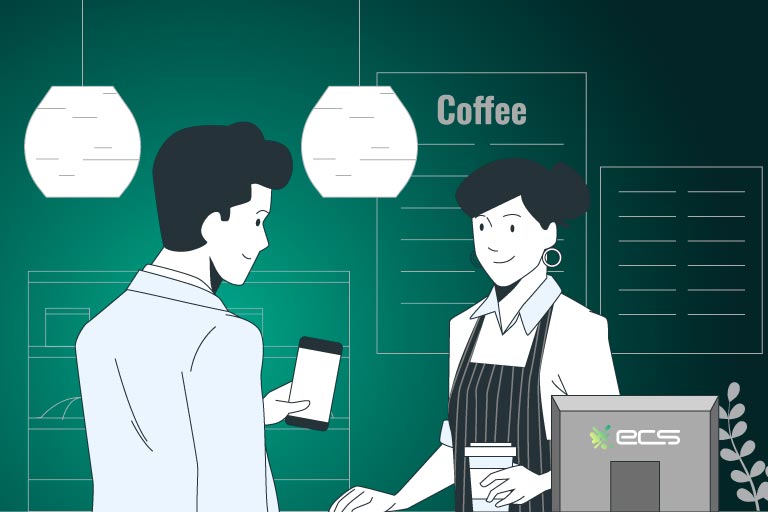Payment processing often has its own terminology for different transaction types. Even experienced merchants can find this difficult, not to mention those who may be newer to credit card processing.
One area of payment processing terminology that often confuses is descriptors. Descriptors are the code or text next to a charge on monthly statements. The two most common descriptors are a point of sale (POS) charge and a POS debit. While these may seem the same, credit card companies and issuing banks view them differently.
Your customer’s card statements and your own monthly statement from your payment processor will also display these descriptors. Due to their similarity, they can often be difficult to decipher for both you and your customers.
Below, we’ll explain the difference between a POS debit and a POS charge. We’ll also provide tips on using the various descriptors available to reduce your chargebacks, lower your costs, and keep your customers happy.
What Is A Point Of Sale Transaction?
Point of sale systems (POS) are a combination of hardware and software businesses use to handle standard cash register functions and electronic payments. Popular providers such as ECS Payments offer these POS systems, but you can also purchase them directly from vendors.
In retail, you will find these systems at the checkout area used to accept payments. They will have accompanying card readers to accept various payment methods such as dipped, PIN, tap, or swiped using a credit or debit card.
Online retailers may also process transactions through POS software, depending on their ordering workflow. Credit card statements label any card processed via a POS system with the “POS” descriptor.
Let’s take an example: Suppose you visit a local coffee shop and order a drink to go. After ordering, you use your credit card to pay the amount of $5. You tap your card on the card reader attached to the shop’s POS system.
When you review your bank statement for that credit card later, the coffee shop charge will appear with the “POS” descriptor. It may also have other descriptors, such as the business name and possibly descriptors for the products purchased.
In the context of the coffee shop, when the owner or accountant examines their monthly statement from the payment processor, they will notice that the charge is labeled with the same POS descriptor. In the context of the coffee shop, when the owner or accountant examines their monthly statement from the payment processor, they will notice that the charge is labeled with the same POS descriptor.
A credit card transaction does not immediately debit a customer’s bank account. Instead, the issuing bank essentially lends the money through the network, which the cardholder pays back according to their agreement with the issuing bank.
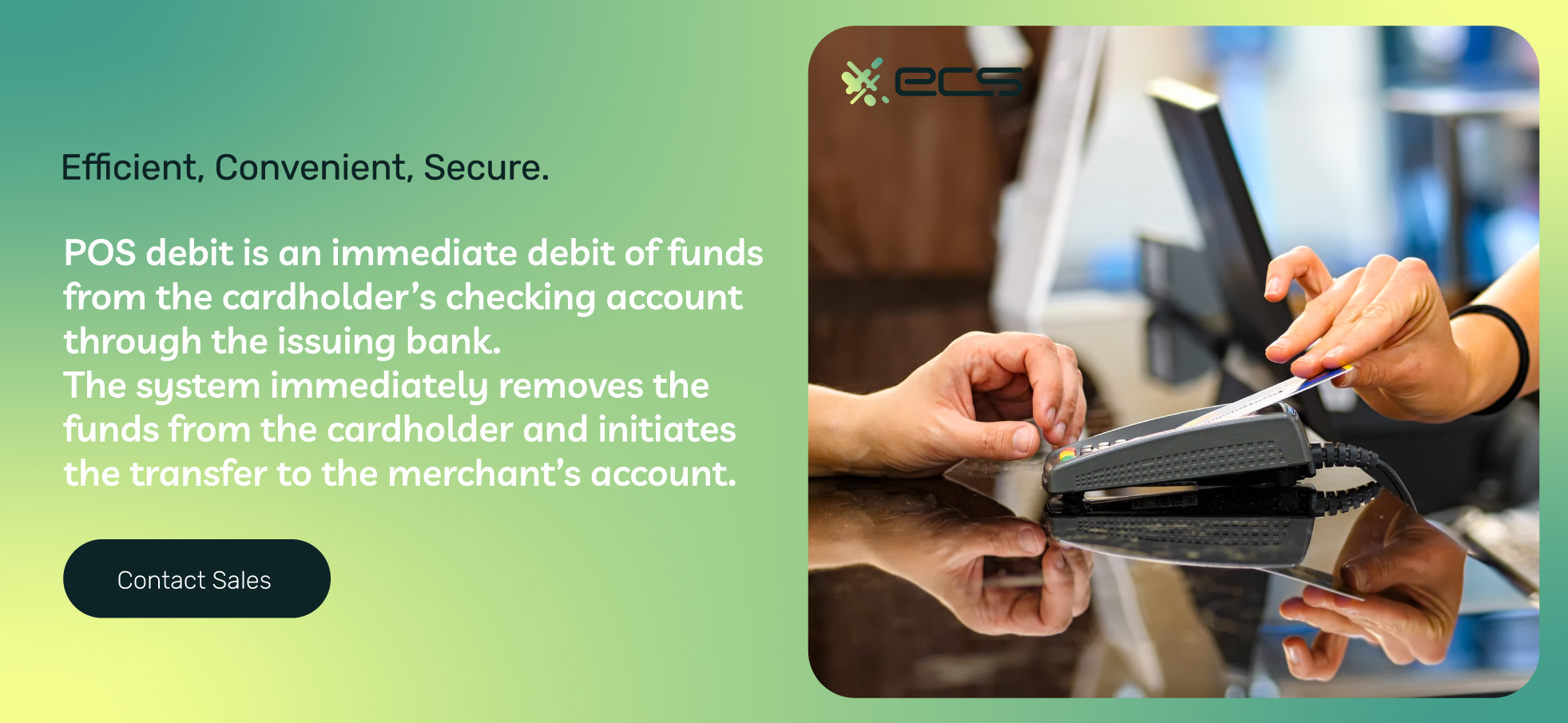
What Does POS Debit Mean?
Recent studies concluded that 56% of all purchases come from non-prepaid debit cards. A debit card purchase is very similar to the explanation above, except that it involves using a debit card. The transaction will still assign the POS descriptor but will also label it as a “debit.”
So, using the coffee shop example above, if you used a debit card instead of a credit card, your statement would show a POS debit along with the other descriptors, such as the name of the coffee shop. This would be an example of a point-of-sale debit card transaction.
Similarly, the monthly statement issued by the coffee shop’s payment processor would label it as a POS debit because it is a debit card transaction.
The difference is that a POS debit is an immediate debit of funds from the cardholder’s checking account through the issuing bank. The system immediately removes the funds from the cardholder and initiates the transfer to the coffee shop’s merchant account.
These examples for a POS charge and POS debit seem simple, but they are both PIN-verified transactions. When payments are not PIN verified, the descriptors can change, which is where a lot of the confusion occurs for merchants and customers.
Visa Debit vs. US Debit
On some EMV readers, there is an option for customers to choose Visa debit or US Debit. In these cases, the customer can select whether to run the transaction as a debit or a credit charge. So, whether the transaction is sales debit or credit is up to the customer. This option may not be available for all transactions, depending on the card issued.
What Are The Different Debit Transactions?
PIN Debit
PIN debit is when a customer provides their PIN to use their debit card. Tap, swipe, or dip transactions can sometimes require a PIN. PIN requirements can vary by retailer and their merchant agreement.
Signature Debit
These are instances where the customer signs a receipt after a debit card transaction. Signature debit is common in restaurants or bars where the customer may add a tip to the final bill and then have to sign. Occasionally, larger purchases may require a signature depending on the retailer and the transaction.
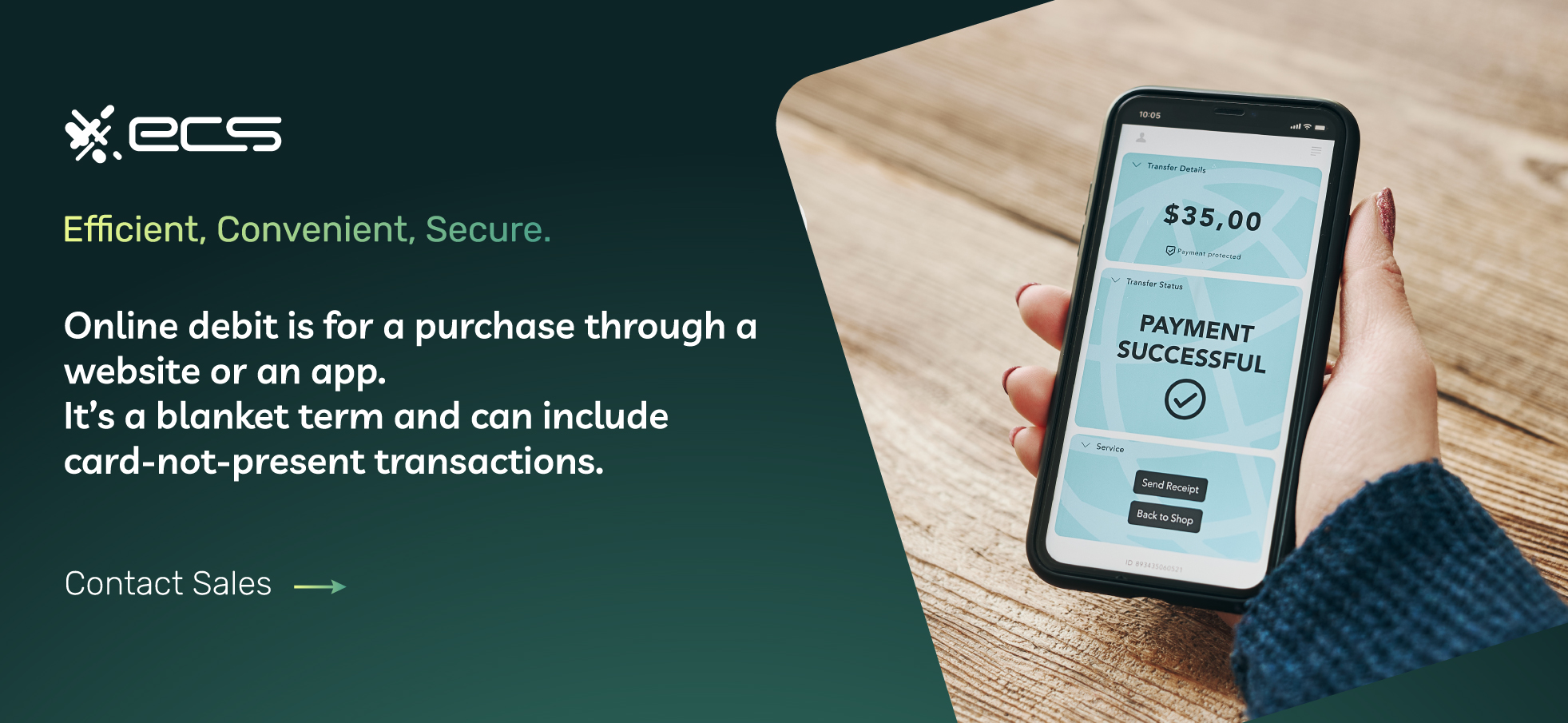
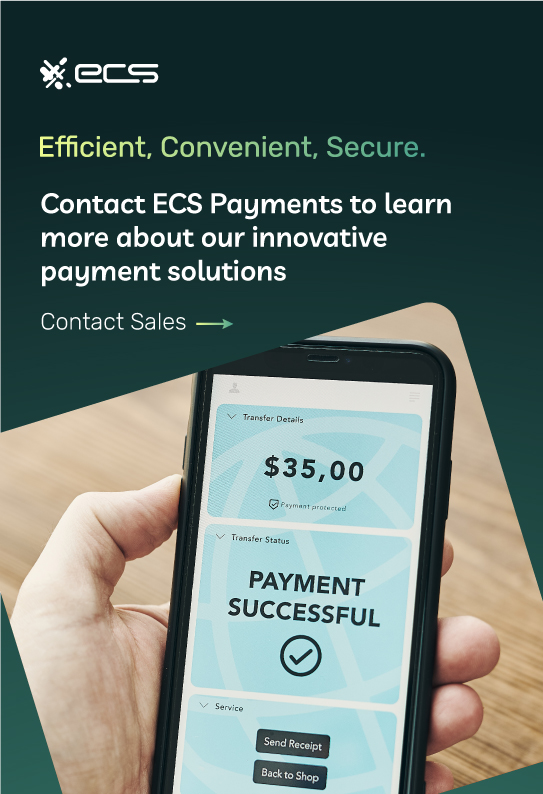
Online Debit
Online debit is for a purchase through a website or an app. It’s a blanket term and can include card-not-present transactions.
Phone Debit
The merchant handles phone debit via a virtual terminal, which is sometimes part of a POS terminal. These will often require AVS and CVV information. Phone debits include examples such as when customers order by phone.
The merchant’s customer service representative enters the debit card information into the virtual terminal to complete the transaction. Another example would be a donation to charities made by phone. If the donor used a debit card to donate, it would result in a phone debit.
Recurring Debit
Recurring debits are transactions typically run every month for memberships, subscriptions, or installment payments of any kind. Depending on the initial payment, these may have originated as a PIN or a card-not-present debit.
A common example of recurring debits would be for a gym membership. The customer would submit their debit card and agree to the recurring payment schedule.
Another example would be a subscription box online retailer. These retailers have a subscription and then send monthly packages to their customers.
ATM Card vs. Debit Card
ATM withdrawals using a PIN with a debit are similar to a standard PIN debit transaction. In these transactions, the system immediately withdraws money from the account.
Other Statement Descriptors
There are many times when PINs are no longer required to complete a transaction. The cause of this can be the method used to capture the card information or the transaction amount.
For example, some retailers no longer require PINs for transactions under a certain dollar amount. The leniency can be due to low fraud associated with this type of transaction, as seen by the credit card networks. It also speeds up overall processing and checkout procedures. When a PIN is not used, that transaction has the descriptor of “DBT” instead of POS debit.
For modern transactions, this can be for transaction types such as contactless payments. These include tap-to-pay or other near-field communication (NFC) methods. NFC payment is common with digital wallets such as Apple Pay with an iPhone or Apple watch.
Depending on the retailer and the transaction amount, these transactions may still require a PIN. But a POS purchase, non-PIN, will receive the DBT descriptor.
Card Not Present Debit Transactions
So far, we’ve covered the POS transaction types that involve the customer physically being at the business location and presenting a card. However, many transactions take place when a card is not present. Card-not-present transactions are usually for online transactions or recurring purchases. People use debit cards for these purchases but do not use or record the PIN when doing so.
There is a higher risk of fraud for these transactions, and they generally come with higher processing fees because of that. The system will not assign the POS debit descriptor to these transactions, as card-not-present transactions use their own descriptors.
Before authorization, different levels of fraud protection will also apply to these transactions, including Automatic Address Verification (AAV) and Card Verification Value (CVV).
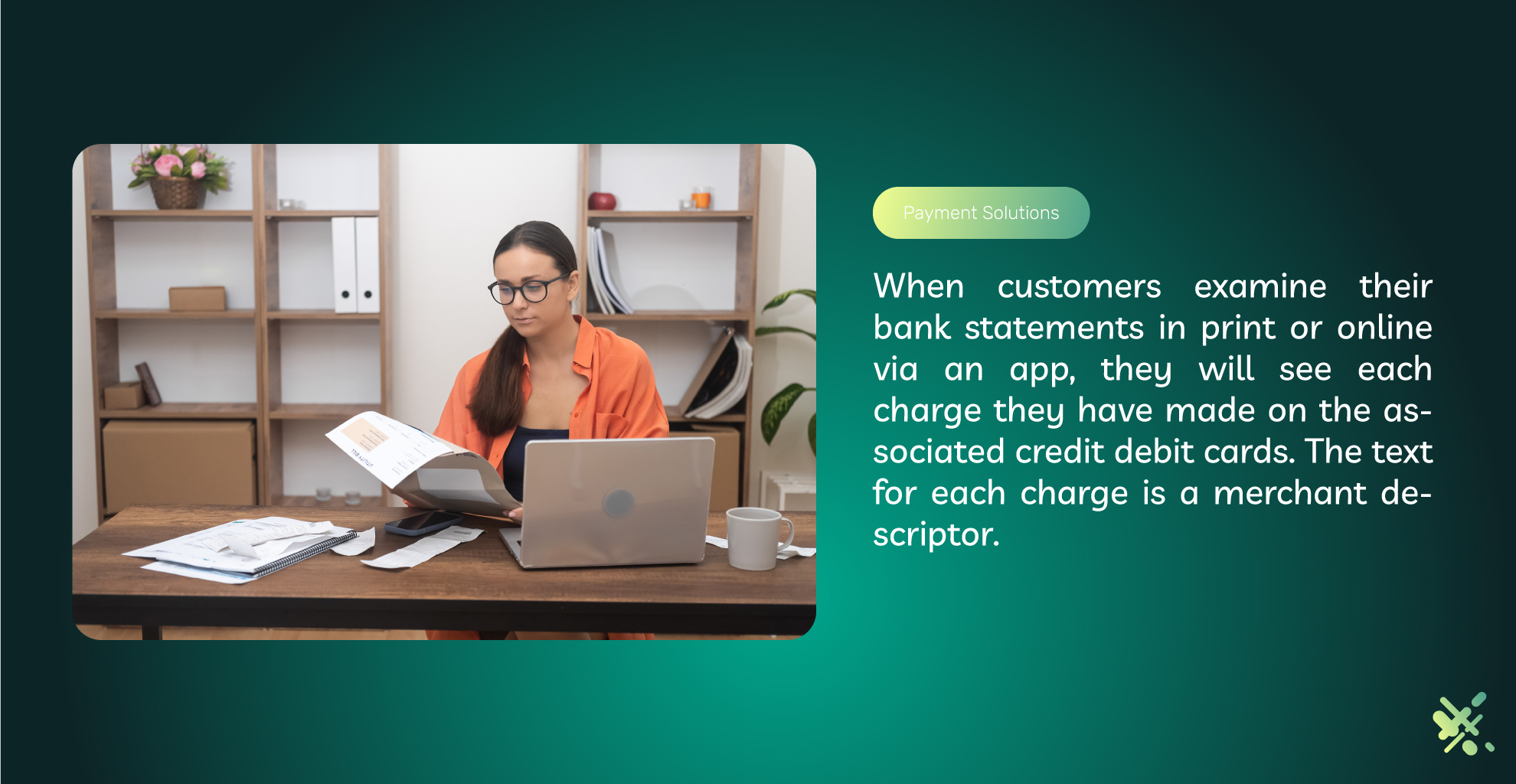
An Explanation of Merchant Descriptors
When customers examine their bank statements in print or online via an app, they will see each charge they have made on the associated credit debit cards. The text for each charge is a merchant descriptor.
We’ve discussed common descriptors such as “POS” and “POS Debit” with the type of transaction conducted for that particular purchase. However, descriptors have other roles that are just as important as determining the type of charge.
The Different Types of Descriptors
Different categories encompass descriptors, each serving a specific purpose and conveying the intended information.
Dynamic Descriptor
A dynamic descriptor changes depending on the transaction. For example, POS and POS Debit descriptors are dynamic because they can change depending on the charge. The card network puts these in place as it runs the transaction, and the merchant has no control over them.
Not all merchant accounts will transmit dynamic descriptors. To forward the information to the issuing bank, the merchant’s payment processor must support this function.
Static Descriptors
These are default descriptors that will show up on the customer’s statement. These stay the same no matter what purchase or transaction type it is.
Businesses should choose these carefully to be helpful and allow room for other important information to be displayed when needed. These static descriptors also have character limits. Therefore, choosing descriptors that make sense even when shortened is important.
Soft Descriptor
Pending transactions use soft descriptors. For example, when you make a purchase with a debit card, it may pend for up to 3 days before it finally settles. During this time, the customer may see a soft descriptor during the pending period. Upon settlement, the final descriptor will appear.
These are hidden for many aggregate merchant accounts, such as Stripe or Square. The original pending charge may only show that it is from Stripe. Once settled, the full descriptor with the business’s name will appear on the customer’s statement.
The issuing bank frequently determines how to display the information. Other factors can also play a role.
Unfortunately, this can confuse customers as they may not recognize a charge if the descriptor is incomplete during the pending period. Customers then falsely claim fraud or will initiate a chargeback.
Soft descriptors are sometimes not accurate with aggregate payment processors because they don’t issue individual merchant accounts to their merchants. Instead, they all share a single merchant account.
Combined accounts is one of the many drawbacks of using an aggregate payment processor instead of a true merchant account provider.
Why Descriptors Are Important
Descriptors serve many purposes that may not be initially obvious to merchants. But below, we’ll go over the important role that descriptors play.

Improve Accounting
For both the merchant and the customer, easily deciphering a charge helps with bookkeeping, either for an individual or an employee using a company credit card. It’s not uncommon for customer monthly statements to have hundreds of items listed.
Glancing over line items quickly and immediately recognizing each charge makes verifying a statement much easier. It also helps detect fraud since unfamiliar transactions generally stand out among quality descriptors.
Keep Customers Informed
In the past, people only used credit cards for larger purchases. But that has changed over the years, and most people pay for virtually every purchase throughout their day with a credit or debit card.
The wide use of card payments can make remembering or identifying a specific purchase difficult for customers. By having accurate descriptors, the customer can more easily determine a specific charge when they check their statements.
Brand Awareness
Having quality descriptors also helps you build your brand image and brand awareness. A poor descriptor can make a business look unprofessional. It may also look like they aren’t using a legitimate payment service.
Having a descriptor that clearly identifies the brand helps build your overall image and a stronger relationship with your customers.
Debit vs. POS Charge and Processing Fees
Fees for debit transactions can be different compared to other POS transaction types. Since a debit purchase means the money comes directly from the customer’s bank account, there is generally less risk involved with those transactions. When the card processing networks assume less rintesk, the fees are lower.
Of course, card companies and even merchants like customers to use credit cards as this allows for larger purchases than they otherwise might make. However, for merchants, debit cards will have lower processing fees.
These processing fees, known as the interchange rate, constitute the base charges for a transaction. Most merchants use interchange-plus pricing. With the interchange-plus pricing fee structure, merchants pay the exact interchange rate plus a set amount based on their agreement with their payment processor.
Your debit transactions will often have a lower overall cost for these types of arrangements. Your payment processor will still have their fees added to the transaction, but the base fee will be lower, resulting in less cost for the merchant.
Why You Need Accurate Merchant Descriptors
Accurate descriptors perform a very important function. They help avoid confusion and prevent merchants from incurring extra fees. So-called friendly fraud is a common type of fraud with electronic payments. In fact, Visa claims that up to 75% of fraud occurs from consumers misuse. With friendly fraud, there is no hacking or stealing of credit card information.
Rather, with friendly fraud, the customer who initiated the transaction disputes it. Sometimes, this is for innocent reasons, and the customer doesn’t recognize or remember the charge. There are other times when the customer does this intentionally, and they take advantage of the policies regarding chargebacks with their card issuer.
Intentional friendly fraud can be difficult for merchants to deal with and mitigate. However, accurate descriptors can prevent the innocent version where the customer forgets or does not recognize the charge.
Some merchants may not even know their descriptors for various purchases or what their customers see on their statements. They also may not be fully aware of what they can modify about their descriptors to help prevent friendly fraud and confused customers.
If you’re unsure about your descriptors, contact your payment processor for more information. They can guide you through the process of changing anything if necessary. They should also be able to explain what your customers will see on their statements when making a purchase through your business.
For additional help, we’ll review some of the best practices for setting up your descriptors to keep your customers well-informed and reduce the possibility of friendly fraud or other disputes that can cost you time and money.

Tips To Create Coherent Merchant Descriptors
Now that you understand the differences between POS debit and other POS descriptors, it’s time to review the best practices to create descriptors for your customers that can reduce confusion and possible chargebacks or reversals.
You should contact your payment processor for help implementing any of these changes.
Include Your Store Name
Including your store name may seem obvious, but many businesses don’t have their brand or store names in the descriptor. This information may be lacking because they originally applied for a merchant account using an LLC. The merchant account is under the name of the LLC, but the business has a DBA (doing business as) under a different name.
For example, let’s assume a business is run by an LLC named XYZ Holdings LLC. However, the business runs a local clothing store named Carol’s Clothing Shop. When customers make a purchase at Carol’s Clothing Shop, the descriptor may say XYZ Holdings LLC.
This can be very unclear for customers. The confusion can also increase chargebacks and harm brand building. If you are using a DBA or have changed the name of your business operation, make sure your credit card processing information is up to date.
For those who run different businesses, you may want to get different merchant IDs to manage those businesses better and provide a better customer experience.
Use A Location
Your descriptor should have a location for the business where the transaction took place. Once again, the address may show the headquarters of the business or the LLC that owns the business.
Keep It Short
There will be character limits, which can vary by the card type and other processing factors. Avoid descriptors that are too long. Cutting off long descriptors can make the result difficult to read.
Most limits are around 25 characters, so keep length in mind. If you need to shorten your descriptor, do so in a way that makes sense and retains the core name.

Think From The Customer Point of View
Remember that these will mostly be for the customer’s benefit so that you deal with fewer disputes. You should avoid using internal naming structures based on acronyms or codes your business or industry uses.
Your customer likely won’t know what any of those mean. So try to use plain language when creating descriptors and avoid jargon or abbreviations that aren’t common knowledge.
Be Consistent
If you manage different locations of the same business, whether in the same state or nationwide, try to use similar naming structures across all your descriptors. Whether the businesses are franchises or separately owned, but all operate under the same umbrella, doing so helps build brand image and keeps customers informed about your billing practices.
Consult With Your Payment Processor
You should consult with your payment processor if you are changing your descriptors or need to make a change at some point in the future. Ask about character limits and other options that may be important. Your payment processor should happily walk you through this process and help you set up your descriptors using industry best practices.
If your payment processor cannot help, you can contact ECS Payments. We offer flexible merchant accounts with customization options so merchants can take full advantage of the features available to lower costs and fight disputes.
Common Descriptors For Merchants
There are a few standard formats for setting up your descriptors that most companies use. As a baseline, you should use best practices whenever you can. However, depending on various factors and limitations, you can modify these to your specific situation.
The most critical element is the business name. It has to be easy to decipher, even at a glance, so it should have priority.
A common example of this would be:
Brand Name + URL (website) + Location (city or zip code)
This format may not always be possible as the character limit and the length of your business name means you have to shorten one or the other. But prioritize the business name over dynamic descriptors like an order or invoice number.
Another example would be to include a phone number. Phone numbers work if your business lacks a URL or if you don’t use it for interactions or support.
For example, you could use the following format:
Brand Name + Phone + Location (City or Zipcode)
This allows people to call the number if they see the charge but don’t recognize it. A phone number allows people to call or search with Google, which most customers do when they see a charge they don’t notice.
The number should come up as your store location, which will help jog their memory and make them remember the transaction.
Having a phone number also helps for general support issues, as people may call about billing questions other than to dispute the charges. If your URL doesn’t have a support area, then a phone number is the best option for your descriptor.
Test Your Descriptors On Different Platforms
Not every financial institution will display your descriptors the same. Some have strict limitations on characters, while others allow for more than one line of text. You’ll want to test these to see how they look on most banking portals.
From there, you can figure out the best way to shorten or abbreviate them so that the most important information shows on most platforms.
More Help With POS Charges and POS Debit Transactions.
The world of payment processing has many acronyms, which can often be difficult to decipher, even for experienced merchants.
This is why having a payment processor that works with you and can be a trusted technology partner as you grow your business is so important.
ECS Payments has been a leader in the digital payment services industry, and we can help your business leverage every possible advantage to lower your processing costs and improve customer satisfaction.
Contact ECS Payments to learn more about our innovative payment solutions and how they can help your business succeed in any environment.
Frequently Asked Questions About POS Debit
Payment descriptors text that appears next to a charge on cardholders’ monthly statements. Descriptors help identify where each charge comes from. A merchant can determine these descriptors, however, ultimately, the cardholder’s bank has the final say on how payment descriptors are displayed on cardholder statements.
Payment descriptors keep customers informed about their purchases, help with accounting, and enhance brand awareness. They keep customers informed, especially when card payments are common for everyday purchases. This is why accurate descriptors can prevent unnecessary chargebacks from an unrecognized transaction. Be sure to check with your payment processor on what you have your descriptor set to.
Businesses can create clear descriptors by including their store name, location, and other pertinent information. Remember that customers know you by your DBA, not your corporate name. Avoid jargon or abbreviations that customers may not understand. Keep your descriptor consistent across different locations. ECS Payments can provide additional guidance and support for our businesses. Give us a call today.
ECS Payments is a trusted one-stop-shop merchant service provider in the payment processing industry. Businesses that work with ECS Payments can leverage innovative payment solutions to lower their processing costs and improve their customer experience. We provide expertise in setting up accurate and clear merchant descriptors, which reduces customer confusion and minimizes chargebacks
